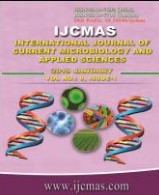


 National Academy of Agricultural Sciences (NAAS)
National Academy of Agricultural Sciences (NAAS)

|
PRINT ISSN : 2319-7692
Online ISSN : 2319-7706 Issues : 12 per year Publisher : Excellent Publishers Email : editorijcmas@gmail.com / submit@ijcmas.com Editor-in-chief: Dr.M.Prakash Index Copernicus ICV 2018: 95.39 NAAS RATING 2020: 5.38 |
The present investigation was conducted during Kharif season of year 2017 at farmers field of Raipur district of Chhattisgarh Plains to find out effect of different land configuration techniques for pigeonpea cultivation on growth, yield and yield attributes on pigeonpea crop. All treatment had significant effect on growth, yield and yield attributing characters like plant height, number of branches plant-1, number of pods plant-1, number of seeds pod-1, 100 seed weight, seed yield, straw yield and harvest index. T1 –ridge and furrow method with 90 x 20 cm spacing resulted in higher plant height (182.98 cm), number of branches plant-1 (17.97), number of pods plant-1 (147.67), number of seeds pod-1 (3.55), 100 seed weight (10.24 g), seed yield (16.91 q ha-1), straw yield (44.31 q ha-1) and harvest index (27.62 per cent), respectively and was found superior over rest of the treatments, which was followed by T2 – flat bed method of spacing 90 x 20 cm and T3 – flat bed method of spacing 60 x 20 cm. The minimum value of all above growth, yield and yield attributing characters was associated with crop sowing with broadcast method.
 |
 |
 |
 |
 |